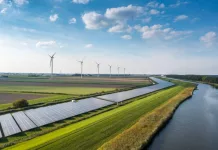Progress in Solar Energy Development and Community Consensus
In the face of growing resistance to solar power developments, a proactive approach was conceived by Dan Reicher from Stanford University’s Woods Institute For The Environment. With concerns over delayed or even scrapped solar projects due to public dissent, the need for a harmonious solution became evident.
Spearheading collaboration with the Nature Conservancy and the SEIA, discussions were initiated among various groups. The fruits of these discussions came to light on October 12, 2023, with a monumental agreement involving solar industry leaders, conservationists, agriculturists, and various other factions, including environmental justice and tribal groups.
Brokering the Agreement
The union of these diverse groups signifies a crucial pivot towards advancing US solar projects while simultaneously respecting conservation efforts and community interests. Over the coming decade, the expansion of solar energy output in the US is predicted to skyrocket by five times, fostering clean and affordable energy. Yet, this growth brings challenges like land use conversion, wildlife conservation, and local community involvement.
The Solar Uncommon Dialogue agreement underlines the necessity of transparent, fair, and effective strategies for massive solar project development, suggesting that compromises are inevitable. The signatories have vowed to optimize solar development with a focus on what they’re calling the “3Cs”—climate, conservation, and community.
Formulating a Path Forward
Key to the agreement are six dedicated working groups targeting crucial areas such as community involvement, risk assessment in solar siting decisions, agricultural technology, tribal community interests, and shaping policy answers. These groups aim to propel the 3Cs by enhancing participation, refining solar placement, tweaking regulations, and offering financial incentives through various measures.
Reicher, who also served as the Assistant Secretary for Energy Efficiency and Renewable Energy, underscores the importance of resolving the increasing conflicts surrounding US solar projects. He professes delight in the willingness of the parties to seek and develop impactful resolutions.
Voices of the Agreement
Abigail Ross Hopper, SEIA’s president and CEO, acknowledges the imperative of prioritizing local involvement as the solar and storage industry burgeon. Through this landmark agreement, the industry intends to deploy projects quickly yet responsibly and equitably. Jen Morris, CEO of The Nature Conservancy, also champions this balance, emphasizing environmental considerations in the renewable energy push.
This comprehensive tactic to solar energy development comes at a crucial time when conflicts over land aesthetics, property value, and wildlife habitats surface. Although the pact brings influential voices together, excluding certain critical stakeholders like the fossil fuel industry or conservative groups could raise questions about its overall impact on local community opposition.
Despite the potential gaps, proponents believe it will expedite resolutions between developers and concerned parties. Energy Secretary Jennifer Granholm heralded these discussions as stepping stones towards achieving clean electricity and conservation goals while being methodical.
A shining example of the envisioned approach is the Starfire solar project in Kentucky. With Rivian as its affiliate, this former coal mine site is being transformed into a solar power station, reflecting the type of progress stakeholders hope to replicate nationwide.
Overcoming Obstacles and Embracing New Perspectives
Dissent towards renewable energy projects often stems from selective criticisms that overlook broader implications, such as the environmental costs of conventional energy extraction and its climatic consequences. Advocates contend that many protests could be mitigated by ensuring local communities benefit directly from the projects.
The notion that local communities should be stakeholders in these initiatives could potentially subdue opposition, fostering a supportive atmosphere for renewable energy deployment. It draws attention to the importance of inclusion and shared benefits in the energy transition narrative.
This collaborative agreement not only represents a leap towards sustainable energy but also underscores a growing understanding that resolving conflicts with renewable energy siting requires more than just negotiations—it necessitates a shift in how local communities are engaged and compensated. The ultimate goal is to achieve a balanced path that equally values the environment, the economy, and the people.

























